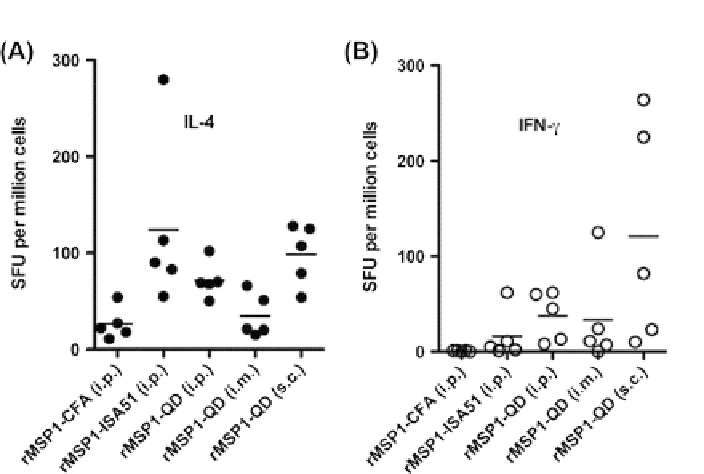Biomedical Engineering Reference
In-Depth Information
FIGURE 7.7
IL-4 and IFN-γ responses induced by rMSP1-QD and other adjuvants. A) MSP1-
specific IL-4 and B) IFN-γ as determined by ELISPOT. Horizontal bars indicate mean SFU. Mouse
splenocytes were harvested 21 days after the last immunization.
Courtesy of Pusic et al., 2011.
stimulation of BMDCs by QDs enhance the migratory characteristics of these
immune cells resulting in more efficient antigen presentation and/or T cell
activation. The QDs showed induction of the production of some chemokines
(CCL3/CCL4) at levels similar to those that are induced by LPS stimulated
BMDCs which indicated their potential to activate a strong immune response as
shown in
Figure 7.8
.
213
When the purified tertiary bleed mouse antibodies were pooled and tested
for parasite inhibition in vitro, the antibodies produced using QD-based delivery
inhibited parasite growth from 73% to 81% (
Table 7.1
). The antibodies produced
using the QD-based vaccine delivery were more potent in inhibiting the
Plas-
modium falciparum
growth compared with the antibodies induced by commer-
cial adjuvants, CFA, and Montanide ISA51.
213
The study provides promising
results for water soluble, inorganic NPs (<15 nm) as platforms to enhance the
immunogenicity of peptide vaccine candidates in adjuvant-free immunizations.
7.5 NM
s
FOR THERMAL ABLATION
For patients with unresectable malignancies, the standard of care is chemotherapy
and external beam radiation.
3
When these do not work out, alternative treatments
are needed. Currently, local thermal ablation under ultrasound or computed tomog-
raphy guidance are used as alternative methods.
214,215
Thermal ablation uses heat
treatment to destroy a tissue or to impair its function. This method has been rou-
tinely used for the treatment of uterine bleeding, atrial fibrillation primary lung

